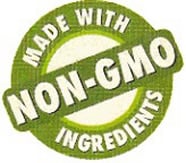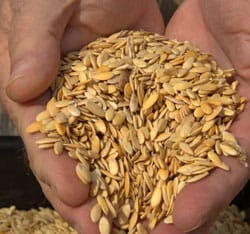Non- GMO Labeling is a Hit with Consumers
This is an interesting report from the Nielsen company- the same company doing the familiar Nielsen Ratings.
The consumer interest in Non-GMO labeled foods is skyrocketing. In 2009, this micro market segment was worth $60.2 Million and grew at 67% over 2008, making it the #1 healthy eating trend in store brands for 2009. Store brands are like Topco Full Circle and Safeway “O” Organics. Store brands like these now make up almost 40% of products with no preservative claims, 25% of all organic product sales, and nearly one-fifth of all products with “natural” claims in food/drug/mass merchandise retailers. Whole Foods Market, one of the largest U.S. natural foods retailers, have started the process to certify that all of their store brands are GMO free.
What is even more interesting is the early adoption of the Non-GMO labeling by store brands, which are taking the lead in offering healthy products instead of trailing the major brands as they used to do. Consumer sentiment against genetically modified foods (GM or GMO) is growing- despite all of the marketing and press support by genetic engineering companies like Monsanto- and market brands are reflecting that. With GMOs being linked to organ damage, crop failures, increased water usage, soil contamination and worse, consumers are becoming aware of the dangers of these products. Another major winner is the “No high fructose corns syrup” label worth $13 Million and growing at 28% over 2008. That gives it a #10 rank.
These dollar amounts are big numbers to most of us consumers, but are small potatoes to the large national brands, such as Lays and Kraft. What makes them take notice is the growth percentage. They will be watching the growth in several of these segments to see if there is consistent, sustained growth that makes it financially feasible or even necessary for them to switch suppliers from conventional to non-GMO. If there is enough movement in the market towards GMO free products, they will switch, as they will not stand by and watch a large market share evaporate.
This happened in the recent past with RBGH or RBST, the bovine growth hormone developed, not suprisingly, by Monsanto to increase the milk output from cows. It created many other problems, such as increased infections in the milk and disease in the cows. The FDA stated RBGH did not alter the milk, and sued several dairies that labeled their milk RBGH free. Enough consumers found out the truth and started requesting RBGH free milk. Not long afterwards, the major players saw the movement in the market and made the switch to RBGH free suppliers. Surprisingly, this didn’t take a majority of consumers, only 5-7% of Americans, as they represent several hundred millions of dollars to the major national brands. This is money they will not lose when they can make a switch in suppliers and keep their customers happy.
Monsanto is worried, of course. When, not if, the major national brands make the switch, Monsanto will find itself with many highly expensive bio-engineered products that no one wants. They are already in trouble in Europe, as they have lost several recent lawsuits they filed to force their way into European markets and agriculture. The nations of the European Union and more importantly- it’s people- have rejected genetic engineering of food almost out of hand.
What this means for you and I is great news. Safe, wholesome and sustainable food is at the core of our needs, next to clean air and water. With people starting to actively request GMO free labeling on their foods, safer foods are closer and easier to get for everyone.










Well, I’m glad that I’m not the only person uncomfortable being used as a lab rat for the agricultural industry!
You’re not even close to being alone, Lisa!
9 out of 10 Americans surveyed said that they are opposed to unlabeled GMO food.
The local food movement- including CSA’s, Farmer’s Markets, Slow Food Conviviums, and the like are growing faster every day, as more and more people start questioning what is in their food, and start making choices to eat more healthy, more sustainable and increasingly local food. This has the industrial petrochemical agribusiness giants worried that we won’t want what they have for sale…
Thanks for the info on this trend. I watched Food, Inc. not so long ago and was horrified at the way that Monsanto is allowed to control so much of what we eat. Scary stuff.
I just went over to Monsanto.com and gave them a little piece of my mind.
Thanks for the comment on Monsanto, but please don’t stop there!
Do something real and useful and healthy for yourself and your family- go to your local Farmer’s Market, get to know some of the people growing the fresh, healthy and sustainable food there, and start to grow some of your own. Become part of the local food web in your area.
No doubt that food containing pesticides and herbicides causes damage to our body cells.
No doubt that food containing chemical artificial additives such as dyes, filaments, preservatives (nitrites and others), spices, odors, and MSG cause damage to our cells.
No doubt that artificial sweeteners such as aspartame, nutra-sweet, sweet’n’low, and alike cause damage to our cells.
No doubt that antibiotics and rBGH administered to animals we consume as meats and milk cause damage to our cells.
No doubt that the microwaved food causes damage to our cells.
However, all of the above can be easily dropped, discontinued, avoided, eliminated, swept from the stores, from our kitchens, from the planet Earth.
None of the can be done to monsters that are Genetically Modified Objects — whether plants or animals – like salmon which is rumored to become a GMO fish.
Hiroshima and Nagasaki coupled with Chernobyl caused damage to Earth and human’s health millions of times smaller than the GMO foods and animals can do. Because you can revive the planet in 120-300 years after a nuclear catastrophe.
But there is no way (even in a science-fiction movie) to get a normal corn on the cob, or soy, or salmon, or potatoes, or papaya BACK on this planet once all seeds would derive from the genetically engineered/modified once (then cross-pollinated) – that would be healthy to produce, feed, and grow people of a kind we are now. The Earth would die, and the way we would look, behave, and function will never be anything close to what it is known as the homo sapiens today.
So right you are, Marta!
Very succinctly put, as well. Thank you so much for contributing this!
You are too right, since I was a teen I was aware of the chemicals that they are always adding to everything. Then they started fiddling with the genes. Yet even more nasty side effects have been discovered.
I have recently been able to impact my families diet, and I already see a difference in just changing the food from prepackage to home prepared. After the success of my trial garden, I will be starting a real plot using only heritage (heirloom) seeds and I can’t wait to see even more of a difference.
I loved your post, and I hope that more people take action, even if it is just a few steps in the right direction.
Michelle-
Thanks! Good luck on the garden, keep us posted as to how it grows.
So are you saying that all Full Circle products are GMO free??
No, that statement wasn’t made anywhere in the article. The second paragraph shows that store brands that have non-GMO labeling, certified organic, no preservatives, or have other “natural” claims on their labels were “the #1 healthy eating trend in store brands for 2009.” Seeing that store brands were taking an early lead in labeling GMO ingredients was a very positive trend, as shown by Whole Foods.